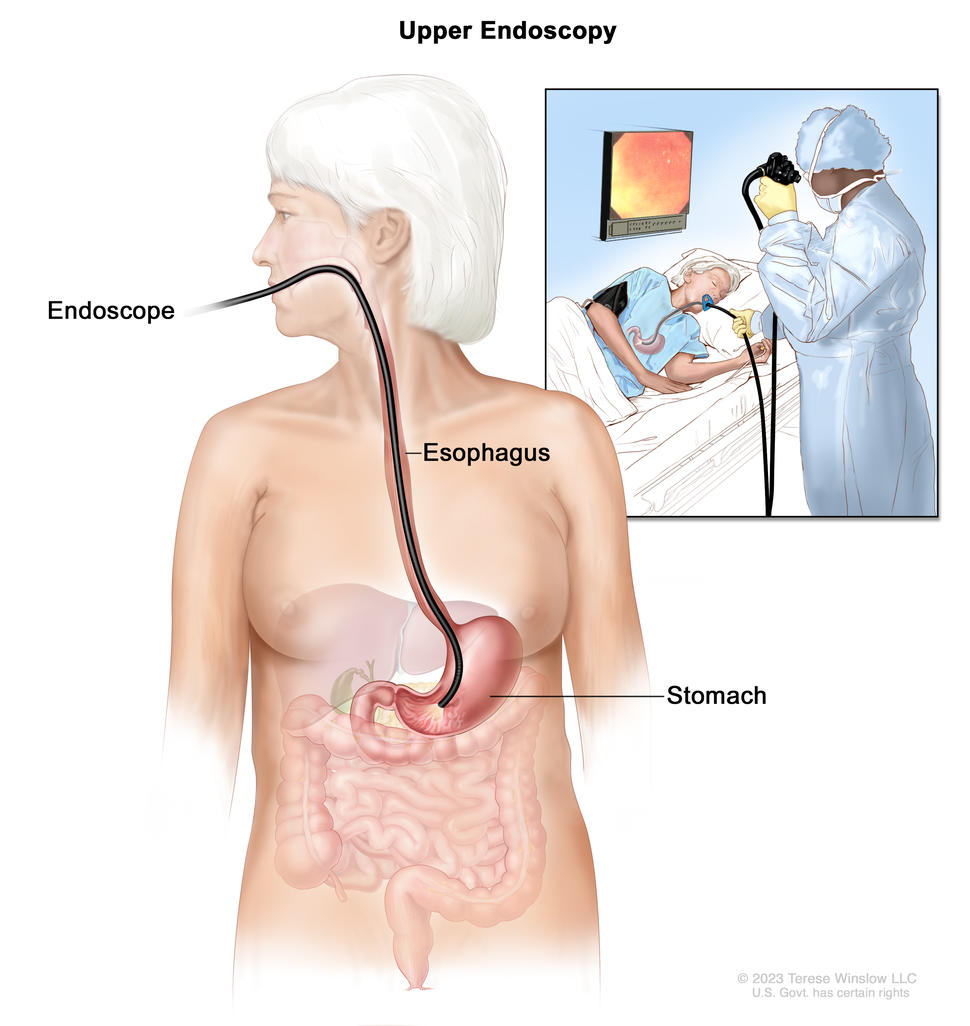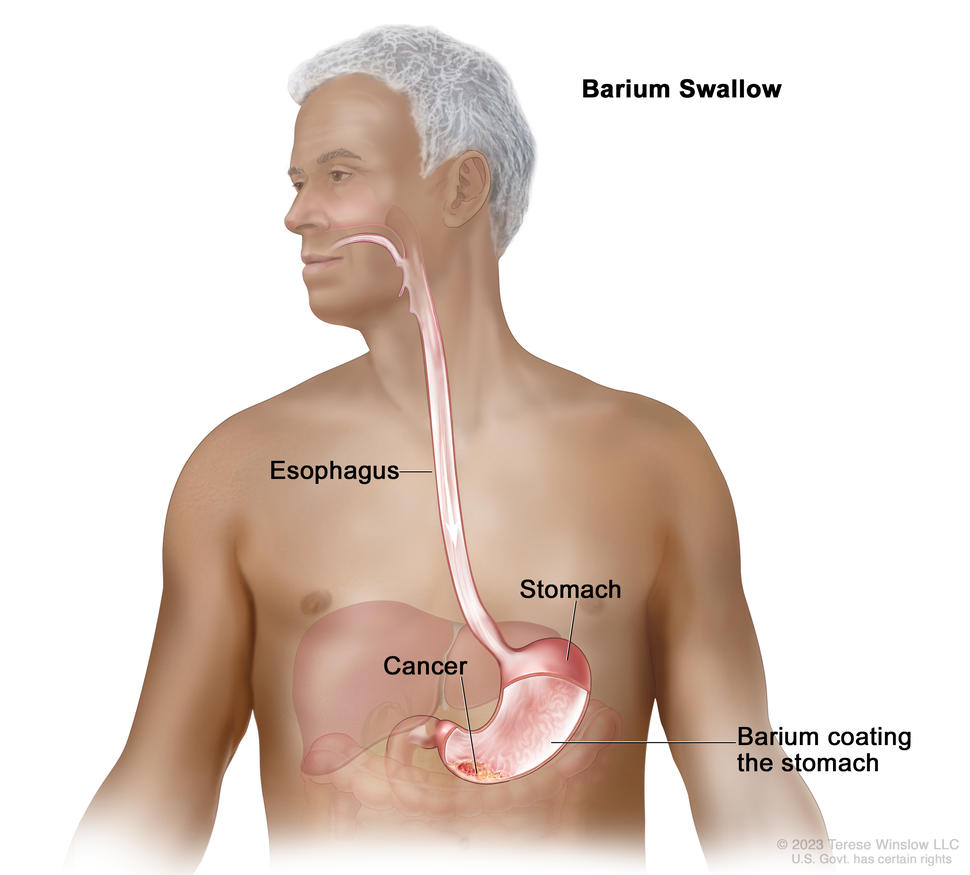Tests to diagnose stomach cancer
The following tests and procedures are used to diagnose stomach cancer. The results will also help you and your doctor plan treatment.
Upper endoscopy with biopsy
Upper endoscopy is a procedure to look inside the esophagus, stomach, and duodenum (first part of the small intestine) to check for abnormal areas. An endoscope (a thin, lighted tube) is passed through the mouth and down the throat into the esophagus. It may also have a tool to remove a sample of cells or tissue (biopsy) so a pathologist can view it under a microscope to check for signs of cancer.
The sample of tissue may be checked for Helicobacter pylori (H. pylori) infection and used for biomarker testing.
Talk with your doctor to learn what to expect during and after your biopsy.
To learn about the type of information that can be found in a pathologist's report about the cells or tissue removed during a biopsy, see Pathology Reports.
Barium swallow
Barium swallow is a series of x-rays of the esophagus and stomach. The patient drinks a liquid that contains barium (a silver-white metallic compound). The liquid coats the esophagus and stomach, and x-rays are taken. This procedure is also called an upper GI series.
CT (CAT) scan
A CT scan uses a computer linked to an x-ray machine to make a series of detailed pictures of areas inside the body from different angles. A dye may be injected into a vein or swallowed to help the organs or tissues show up more clearly. This procedure is also called computed tomography, computerized tomography, or computerized axial tomography. To learn more, see Computed Tomography (CT) Scans and Cancer.
Biomarker testing
Biomarker testing is a way to look for genes, proteins, and other substances (called biomarkers or tumor markers) that can provide information about cancer. Some biomarkers affect how certain cancer treatments work. Biomarker testing may help you and your doctor choose a cancer treatment for you.
To check for these biomarkers, samples of tissue containing stomach cancer cells are removed during a biopsy or surgery. The samples are tested in a laboratory to see whether the stomach cancer cells have these biomarkers.
For stomach cancer, biomarker testing includes the following:
- HER2: The cancer cells may have larger than normal amounts of a protein called HER2.
- PD-L1: The cells may have larger than normal amounts of an immune checkpoint protein called PD-L1.
- Microsatellite instability: The cells may have microsatellite instability. This may be caused by mistakes that don’t get corrected when DNA is copied in a cell.
- Mismatch repair deficiency: The cells may have a defect in a mismatch repair gene.
- Tumor mutational burden: If the cells have a high tumor mutational burden, it means they have many gene mutations.
- NTRK: The cells may have changes in one of the NTRK genes.
Learn more about Biomarker Testing for Cancer Treatment.
Learn more about Stomach Cancer Treatment.
Tests to stage stomach cancer
Stomach Cancer Stages
Find information about a specific stage of stomach cancer, a factor that affects treatment.
If you're diagnosed with stomach cancer, you will be referred to a gastrointestinal oncologist. This is a doctor who specializes in diagnosing and treating cancers of the stomach and intestines. Your doctor will recommend tests to find out if the cancer has spread and if so, how far. Sometimes the cancer is only in the stomach. Or, it may have spread from the stomach to other parts of the body. The process of learning the extent of cancer in the body is called staging. It is important to know the stage of the stomach cancer to plan treatment.
The following imaging tests and procedures may be used to find out your stage:
- Endoscopic ultrasound is a procedure in which an endoscope is inserted into the body, usually through the mouth or rectum. An endoscope is a thin, tube-like instrument with a light and a lens for viewing. A probe at the end of the endoscope is used to bounce high-energy sound waves (ultrasound) off internal tissues or organs and make echoes. The echoes form a picture of body tissues called a sonogram. This procedure is also called endosonography.
- PET-CT scan combines the pictures from a positron emission tomography (PET) scan and a computed tomography (CT) scan. The PET and CT scans are done at the same time on the same machine. The pictures from both scans are combined to make a more detailed picture than either test would make by itself.
- For the PET scan, a small amount of radioactive glucose is injected into a vein. The scanner rotates around the body and makes a picture of where glucose is being used in the body. Cancer cells show up brighter in the picture because they are more active and take up more glucose than normal cells.
- For the CT scan, a series of detailed x-ray pictures of areas inside the body is taken from different angles. A dye may be injected into a vein or swallowed to help the organs or tissues show up more clearly.
- Magnetic resonance imaging (MRI) with gadolinium is a procedure that uses a magnet, radio waves, and a computer to make a series of detailed pictures of areas inside the body. A substance called gadolinium is injected into a vein. The gadolinium collects around the cancer cells so they show up brighter in the picture. This procedure is also called nuclear magnetic resonance imaging (NMRI).
- Laparoscopy is a surgical procedure to look at the organs inside the abdomen to check for signs of disease. Small incisions (cuts) are made in the wall of the abdomen and a laparoscope (a thin, lighted tube) is inserted into one of the incisions. Other instruments may be inserted through the same or other incisions to perform procedures such as removing organs or taking tissue samples to be checked under a microscope for signs of cancer. A solution may be washed over the surface of the organs in the abdomen and then removed to collect cells. These cells are also looked at under a microscope to check for signs of cancer.
Getting a second opinion
You may want to get a second opinion to confirm your stomach cancer diagnosis and treatment plan. If you seek a second opinion, you will need to get important medical test results and reports from the first doctor to share with the second doctor. The second doctor will review the pathology report, slides, and scans before giving a recommendation. The doctor who gives the second opinion may agree with your first doctor, suggest changes or another approach, or provide more information about your cancer.
To learn more about choosing a doctor and getting a second opinion, see Finding Health Care Services. For questions you might want to ask at your appointments, see Questions to Ask Your Doctor about Cancer.
Contact Us for Help
Get live help with finding a doctor, hospital, or getting a second opinion at 1-800-4-CANCER. NCI offers free information on cancer topics in English and Spanish.

